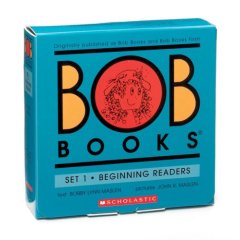curriculum EFL eikaiwa ES extensive reading kids language courses phonics readers Reading reviews teaching
by sendaiben
leave a comment
Bob Books children’s phonics readers
Bob Books are a great low-cost option for schools that want to start phonics practice with students but don’t have the funds available for more extensive purchases.
The newest version consists of five sets (each containing twelve books), which are available from Amazon.co.jp for just over 1200 yen. As this works out at just over 100 yen per book, they are excellent value for money. There are also older versions that contain similar books in slightly different configurations with different names.
We bought our Bob’s Books quite a few years ago, and used them until we found Follifoot Farm. We haven’t really used them since.
My thoughts on the series:
1. the phonics progression is handled quite well, and they are decodable
2. the language used in the books is not graded, making them somewhat challenging for EFL students at times
3. they feel quite cheap, being printed on thinner paper in black and white
4. the pictures are simple line drawings
5. I feel the stories are not particularly inspired, and many of them are driven solely by the phonics rather than the story itself
In short, these are a cheap and relatively effective option. They are certainly better than nothing, but they are not in the same league as Follifoot Farm. If you can’t afford anything else, they will at least get your students reading.
Anyone else use Bob Books?
curriculum EFL eikaiwa ES Jelly and Bean phonics readers Reading
by sendaiben
5 comments
Follifoot Farm (previously: Jelly and Bean) phonics readers
I can’t think of a better series to start my readers roundup.
There is so much I like about Follifoot Farm:
1. it is written, illustrated, printed, and distributed by an individual (a former maths teacher called Marlene Greenwood)
2. it is incredibly well-structured, leading readers through a gentle progression of incrementally more challenging basic phonics constructions
3. the artwork and characters are very appealing
4. the stories are generally interesting -many of them have twists and cute little details
There are currently just over 120 books in the series (our own collection has 145, but that includes discontinued and semi-duplicate books). You can see details of the series here, and worksheets and sample books here.
In my opinion, the first levels are the best. For us, books 1-80 or so are compulsory for our students. Some students choose to continue reading them after that, but the later stories are much more difficult in terms of the language they use. They are perfectly decodable, but it gets harder and harder for students to understand the meaning of the stories.
The earlier books, because of the extremely well-tuned phonics progression and clear pictures, do a great job of easing students into reading.
Starting with ‘a cat’ (the first few books do not have capital letters or punctuation, so they are much less likely to confuse beginning readers), moving through CVC (consonant-vowel-consonant), consonant blends, and vowel blends, this series really is the best thing I have found to bridge the gap between phonics practice and actual reading.
I normally do my best to balance reviews, giving both good and bad points, but in this case there is not much I can say against it. I personally love the books, and after using them with hundreds of students (children and beginner adults), am convinced of their efficacy.
The only thing is that the books are fairly expensive. Bought from the Japanese distributor, they end up costing just under 400 yen each. Buying the full set of 122 books costs 45,000 yen. This would be a considerable commitment for most schools. Add in the fact that you will probably need multiple copies (we have ten full sets!), and it’s a big decision to adopt them. Because of the current exchange rate, buying them directly from the UK could save you money, even after paying the 48% postage.
Another alternative is to buy CDs with digital versions of the books you can use on a computer or screen, or print out yourself. I personally like having the books, but the electronic versions are much cheaper, particularly if you have large classes or a limited budget.
I’m planning to do another post about how we actually use the readers with our students, so I won’t go into details here. I’d also love to hear from other teachers familiar with the series. Do you like it as much as I do? If not, why? It would be great to get some balance in the comments.

curriculum EFL eikaiwa ES expectations extensive listening kids language courses Language learning listening school management self-study teaching
by sendaiben
6 comments
Practicing speaking with (young) learners
I am a strong believer in input-based learning, as that is how I best learn languages myself. However, recently I have started to question this approach, particularly but not exclusively for my younger students.
There does seem to be a ‘silent period’ for most learners, where they are more comfortable listening than speaking. This varies according to age and character, but seems to exist for all learners (even if it is just a few minutes for the most active/outgoing). I wouldn’t take it as far as this school (which enforces a silent period of about 6-8 months), but I like to keep it in the back of my mind.
The arguments for following a silent, input-heavy period seem pretty persuasive to me:
1. learners can get comfortable with the sounds of the language
This is important because if you can’t hear a sound, you’re unlikely to be able to produce it. There seems to be a case for delaying production until students have enough exposure to the sounds and rhythms of a language.
2. learners can become familiar with basic vocabulary and grammatical chunks
Assuming the input is at an appropriate level, learners will be able to hear the same vocabulary and grammatical chunks multiple times, beginning to acquire them.
3. learners can relax, lowering their affective filter and allowing them to focus on the language
This is pure TPR talk, but I find TPR extremely effective for beginners. Being able to sit back and not have to worry about performance seems to make it much easier for learners to pick up language.
However, this is a slow process. We’re talking about hundreds of hours.
In Japan, where most children learn English for an hour or less a week (elementary school age children at our school have 50-minute lessons), it is clearly not enough to expose children to appropriate input and wait for them to want to speak.
I think David Paul was very right to emphasise teaching children basic phonics so that they would be able to do reading and writing homework as soon as possible. I find children find it much easier to remember language when they have heard, said, read, and written it. It also has the happy side effect of seguing into extensive reading. Recently at Cambridge English we have been trying out various reader programs (Follifoot Farm, Story Street, Oxford Reading Tree, Springboard Readers, Rigby Star). On the whole students enjoy reading in class and for homework.
The other thing we have started doing recently is memorizing questions and answers and short dialogues. At first I wanted to make our own materials (something that may yet happen), but soon after that we came across MPI’s QA series, which does almost everything we want and saves us from reinventing the wheel. The books are not perfect, they have a few awkward questions in there and I’m not sure that the QA300 series really works, but they are cheap, easy to use, come with Japanese translations for students and parents to fall back on, and have CDs available.
So far I’ve been pleased with the results. Each student is set a few (2-10) questions to prepare each week, then has a test in their next class. If they can answer perfectly, they clear the question and get assigned new ones. If not, they review the same questions for the next class. Most students enjoy the challenge and are remembering more common questions. A few students love it and are shooting through the series, and some students are really struggling. As the students work individually at their own pace, this is not too much of a problem. On the whole , it’s been a positive development for our school.
So there we go. I still believe in input, but feel that it is not enough for a Japanese eikaiwa context. We supplement with reading and writing as well as memorising question and answer patterns, which seems to help but we’re still not completely where I would like us to be.
What do you think the most effective ways to teach children in an eikaiwa context are?
business conference curriculum EFL eikaiwa ES expectations extensive listening extensive reading kids language courses Language learning listening online resources presentations Reading school management self-study teaching technology theory university vocabulary
by sendaiben
8 comments
Amazing Minds 2011
I’m on the train on the way back to Sendai now, after a long, tiring, and wonderful weekend talking and learning about teaching. Pearson Kirihara was kind enough to invite me to their annual study meet, Amazing Minds, held in Tokyo this year.
The basic idea behind the event is that the publisher’s sales representatives nominate teachers all over Japan who are then contacted to see if they want to attend. Pearson picks up the tab for travel, accommodation, and food, and puts on a two-day program of presentations, discussions, and informal gatherings. Apparently it’s supposed to be a chance for the company to give back to the teaching community, to join and contribute to the dialogue on teaching in Japan, and to get to know individual teachers better.
I was initially skeptical, although having two of my friends (John Wiltshier and Ann Mayeda) presenting made it a lot easier for me to say yes and make the effort to clear my schedule.
The program for the event was three blocks: one on Saturday followed by dinner, then two on Sunday. Each block consisted of an initial one-hour lecture followed by a ninety-minute group activity session, and finally a feedback session to finish off. Each block was three and a half hours, a long time when you are out of practice concentrating. I got a good sense of what my university students go through most days (they have up to five ninety minute lectures per day).
The three lectures were:
“Two Pathways for Successful Language Learning”, John Wiltshier
“Teaching in 2020: Rethinking the Classroom Environment”, Ann Mayeda
“Lesson Analysis Checklist for Elementary School English Education”, Emiko Yukawa
I have to say I really enjoyed the presentations and came away with dozens of actionable ideas. Overall it was a great experience. I did notice a few things that could be tweaked to make it even better, but I have already passed those on to the organizers and don’t need to mention them here. Instead, I’d like to talk about the highlights.
Probably the biggest realization came during the first lecture, as John was talking about procedural and declarative memory, as well as the optimal period for language acquisition. It came to me quite suddenly that perhaps I am not a normal language learner. After all, I learned my first second language when I was five, in a total immersion environment. I have been at least intermediate in six languages, and find it fairly easy to pick up new ones mainly through input and trial and error. Very few people have this kind of background.
The problem is that I have made all sorts of assumptions about teaching and learning that are based on the possibly mistaken belief that my own experiences are generalizable -that I can teach my students as I would like to be taught and this will provide them with an optimal learning environment. If I am an outlier, however, this is unlikely to be ideal for my students. There will possibly be more effective ways of helping them learn and I will have to go back and examine literally everything I do once again with an open mind.
This seems fairly obvious when I write it here, but it seriously had not really occurred to me before.
Fortuitously, my beliefs about language learning are mainly a bias towards large amounts of input of the appropriate level, a desire to encourage my students to become self-directed and independent learners, and a tendency to believe that learners need to practice in order to improve (ie listen if they want to get better at listening, talk if they want to talk, and so on). I don’t think any of these are harmful.
The second, perhaps less revolutionary, but more specific breakthrough came from Ann’s presentation on flipping the classroom. Much like the Khan Academy, she is interested in ways teachers and learners can lever technology in order to do more outside the classroom, in turn allowing them to use their limited class time on more efficient or productive activities.
It’s a concept I have been very interested for a long time, as it ties in with my own beliefs about the best ways to learn a language.
Independent, self-directed learning is the only way students can possibly get the necessary amount of input and practice they will need to master English. The amount of time is several orders of magnitude larger than even the most specialized or intensive language course could provide. Using the power of the internet to facilitate this means that it is easier than ever for students to come into contact with foreign languages.
The only specifically new things for me in the presentation were several iPad/iPhone apps, but the real value came from the way I was reminded of various extremely promising ideas that I had meant to implement, but that had somehow ended up on the back burner.
Creating a Youtube channel for my students, pre-teaching things online so that students to go over them as many times as they need to in order to master them, introducing online resources in a more systematic way, monitoring and advising students as they explore various self-study options.
Hopefully I’ll be able to get started on one or more of these in the near future. I will definitely keep you posted.
Finally, Yukawa-sensei’s presentation gave me a good look at a systematic way of assessing classes and lesson plans. Again, there was nothing new in this presentation, but it was a great opportunity to once again go back and think about things in a slightly different light.
I used to do a lot of classroom observation when I was the ALT Advisor at the Miyagi Board of Education, and although I didn’t have anything as elegant as Yukawa-sensei’s checklist, I was looking at similar things.
I’ll be applying to checklist to my own classes this week, and predict that I will find several areas to work on during the next few months.
I really enjoyed the weekend and hope Pearson continues putting on these events for teachers and that they consider having me back again sometime.
ALTs business EFL eikaiwa ES expectations JHS kids life in Japan school management teaching teaching culture Uncategorized university
by sendaiben
5 comments
Skewed rewards and incentives (why are university teachers at the top of the pile?)
I have taught at private language schools, public elementary, junior high, and senior high schools, and universities in Japan. They roughly rank in that order in terms of prestige, financial remuneration, and ease of getting a job.
A job at an eikaiwa school is the easiest to get, the worst paid, and has the least amount of prestige (want proof? See how estate agents treat you). Working in public schools is better paid, more challenging to get, and is perceived as being higher by society (some of the dwindling prestige of public school teachers rubs off). Finally, a university position tends to pay rather well, involves jumping through various hoops (publications, experience teaching at the tertiary level, Japanese ability, postgraduate qualifications), and confers a reasonably high status (varying somewhat according to the institution in question).
Seemingly illogically, the actual amount of skill required to do the job well seems to run in the opposite direction. I would say, based on my experience, teaching at an eikaiwa, where you will probably have students ranging from 3 to 70 years old, and classes that run the gamut from 40 kindergarteners to one sleep-deprived businessman or a group of senior citizens, requires the most skill to perform well.
Teaching in public schools can provide discipline challenges, but the range of teaching situations is less varied and the curriculum provides a framework that reduces the amount of material teachers need to master.
Finally, teachers at the university level probably need the least amount of teaching skill to get by: their students are selected for academic potential (yes, even at the worst universities) and teachers tend to have the freedom to decide on the content of their classes. University teachers are pretty much encouraged to teach to their strengths, and can get away with teaching a narrow range of material if they so choose.
So why are the positions that need the most skilled teachers the worst paid?
You can see something similar even within public schools: kindergarten teachers are the least well paid and regarded, followed by elementary school teachers, then junior high school teachers, and finally high school teachers. However, if we look at the potential impact that teachers can have upon their charges, the early years are far more influential. Children who have excellent teachers during the first years of their schooling, then mediocre ones later, are likely to do much better than children in the opposite situation. Why then does society seem to have its priorities so badly skewed?
Is this fixable? Can you imagine a world where kindergarten teachers are given the pay, training, and status the importance of their job deserves? Will the cushiness of university positions be reflected in salaries?
As always, comments very much appreciated below.




